Μια συνάντηση με τον Sir Patrick Leigh Fermor. An encounter with Sir Patrick Leigh Fermor
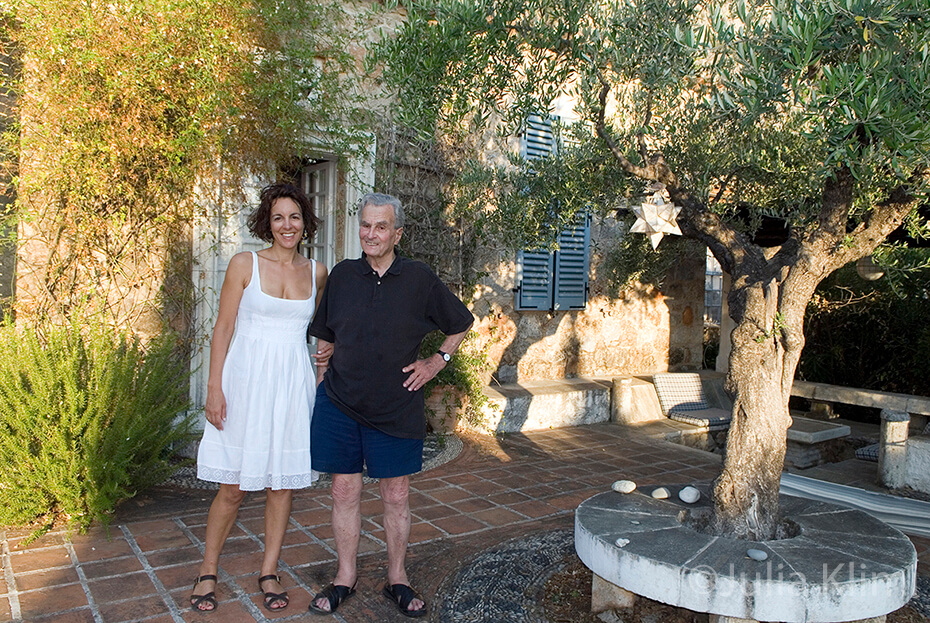
July 2007 Patrick Leigh Fermor & Julia Klimi Kardamili Mani Greece;
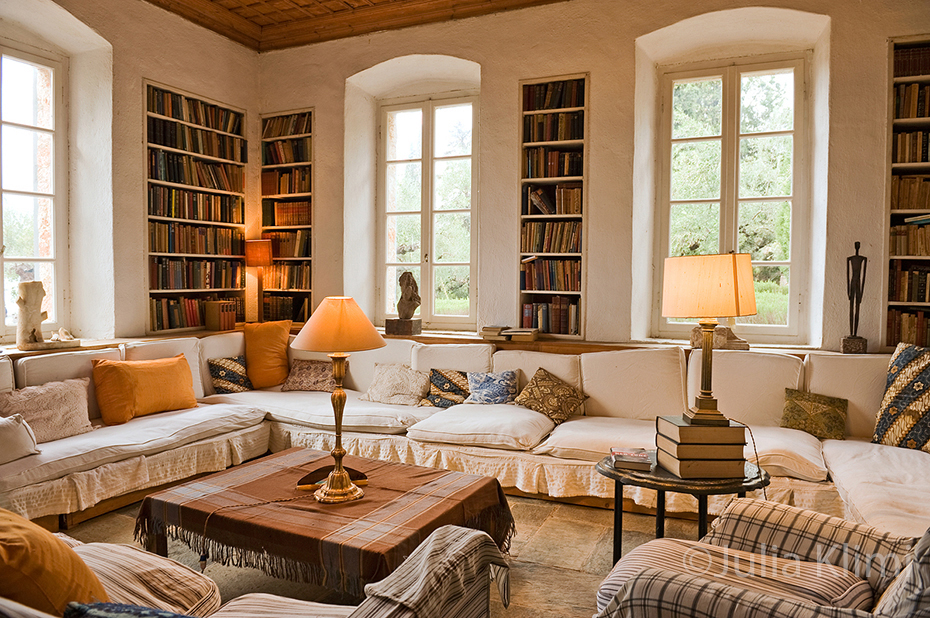
November 8, 2010 Paddy's name day, interior of the house Kardamili
Μια συνάντηση με τον Sir Patrick Leigh Fermor.
Φωτογραφίες -κείμενο Τζούλια Κλήμη
Ιούλιος 2007 στην Καρδαμύλη, μια φίλη πέταξε την ιδέα να γνωρίσουμε τον Sir Patrick Leigh Fermor ενθουσιάστηκα, νομίζοντας ότι είναι κάτι απλό. Τις επόμενες μέρες διαπίστωσα ότι δεν ήταν, το είχα σχεδόν ξεχάσει, όταν κάποιος μου είπε, “έλα να σου συστήσω τον γιατρό του τον κ. Ορφανίδη να πάς μαζί του” εκείνος δέχτηκε πρόθυμα να τον συνοδεύσω.
Αφού κατεβήκαμε την πλαγιά μέσα απο τον ελαιώνα με τις πεζούλες, βγήκαμε σε μια ψηλή μάντρα. Μια ευγενική κυρία μας καλοσώρισε στην ξύλινη πόρτα της αυλής, συνεχίσαμε κατα μήκος του σπιτιού μέχρι που φτάσαμε στην μεγάλη βεράντα όταν είδα το τοπίο ολόγυρα με την θάλασσα έμεινα άφωνη. Τόσα χρόνια που φωτογραφίζω σπίτια ελάχιστες φορές έχω δει σπίτι, τόσο τέλεια εναρμονισμένο με το περιβάλλον. Κάθισα στον εξώστη πάνω απο την θάλασσα και δεν μπορούσα να πάρω τα μάτια μου απο το εξαιρετικό βοτσαλωτό δάπεδο, το πέτρινο τραπέζι με τους καναπέδες με φόντο την θάλασσα. Κάποια στιγμή ο γιατρός Ορφανίδης με φώναξε να με συστήσει, διασχίσαμε όλο το εσωτερικό του σπιτιού και βγήκαμε στην λότζα. Ο Sir Patrick – ο κυρ Μιχάλης για τους ντόπιους, απο το δεύτερο όνομα του, Michael – καθόταν σε ένα τραπέζι/γραφείο στο βάθος της λότζας, σηκώθηκε και μου έσφιξε το χέρι.
Το γραφείο που είχε θέα το βουνό, ήταν γεμάτο με χειρόγραφα και μια γραφομηχανή, μου είπε να καθίσω σε μια καρέκλα δίπλα του. Αυτό μάλλον ήταν «το καλοκαιρινό γραφείο» το πραγματικό ήταν ένα φωτεινό δωμάτιο πίσω μας. Με το τσάι, τον ρώτησα τι γράφει κι εκείνος μου είπε το τελευταίο βιβλίο της τριλογίας (Η τριλογία- που άρχισε να γράφει το 1962 με διακοπή αρκετών ετών- περιγράφει την πεζοπορία που έκανε ο Φέρμορ στα δεκαοχτώ του χρόνια, από το Χουκ της Ολλανδίας στην Κωνσταντινούπολη το 1932-35. Η εποχή της Δωρεάς (1977) ήταν το πρώτο της τριλογίας, το Ανάμεσα στα Δάση και τα Νερά (1986) ήταν το δεύτερο. “Το τελευταίο κομμάτι του ταξιδιού ξεκινάει από τα Ρουμανο-βουλγαρικά σύνορα και θα καταλήξει στην Κωνσταντινούπολη! προσπαθώ να προλάβω” * συμπλήρωσε. “Σπουδαία δουλειά έχετε να κάνετε!”
An encounter with Sir Patrick Leigh Fermor
Text- images Julia Klimi
Translation Vicky Anastasiadou
July 2007. I was on holiday in Kardamyli when a friend threw out the idea that I should get to know Sir Patrick Leigh Fermor. I was excited by the idea, and thought that this would be quite easy, but during the next few days I realized that it was really rather difficult. I had almost forgotten about it when someone offered to introduce me to his doctor, Mr.Orphanides, who then readily agreed to my accompanying him on his next visit to Fermor.
We descended the slope through the terraced olive grove and ended up in front of a high wall with a wooden door. A kindly lady opened the door and welcomed us into the courtyard, where we walked along the side of the house until we reached a large patio. When I saw the view from the house and the sea below, I was speechless. In my long career as a travel and architecture photographer, I had never seen such a house in Greece, so perfectly in harmony with the surrounding landscape.
I sat on the balcony of the patio up above the sea, and couldn’t stop staring at the superb pebbled floor and the stone table and sofas, with the sea in the background. After a brief wait, Dr. Orphanides called me in to introduce me. We passed through the interior of the house and stepped out onto the loggia. Sir Patrick – kir-Mihalis for the locals, as his middle name is Michael, and Paddy to his friends – was seated behind a table that was being used as a desk at the back of the loggia. He sat up and we shook hands.
The desk had a view of the mountain, and was piled with manuscripts and a typewriter.Fermor invited me to sit on a chair next to him. Most likely this was the corner of the house that he used as a summer office, because his real office was in a bright room behind us. Tea served, I asked him what he was writing. He answered that he was working on the last volume of the trilogy he had begun in 1962, and which describes his long walk across Europe from the Hook of Holland to Istanbul at the age of 18, a walk that began in December of 1933 and ended in January of 1935. The first book of the trilogy was entitled, A Time of Gifts (1977), the second, Between the Woods and the Water (1986). “The last part of the journey starts from the borders of Romania with Bulgaria and ends in Constantinople! I am trying to catchup.”he said. “What a great project!” I exclaimed.
Patrick Leigh Fermor house Kardamili 2010, Mani Greece
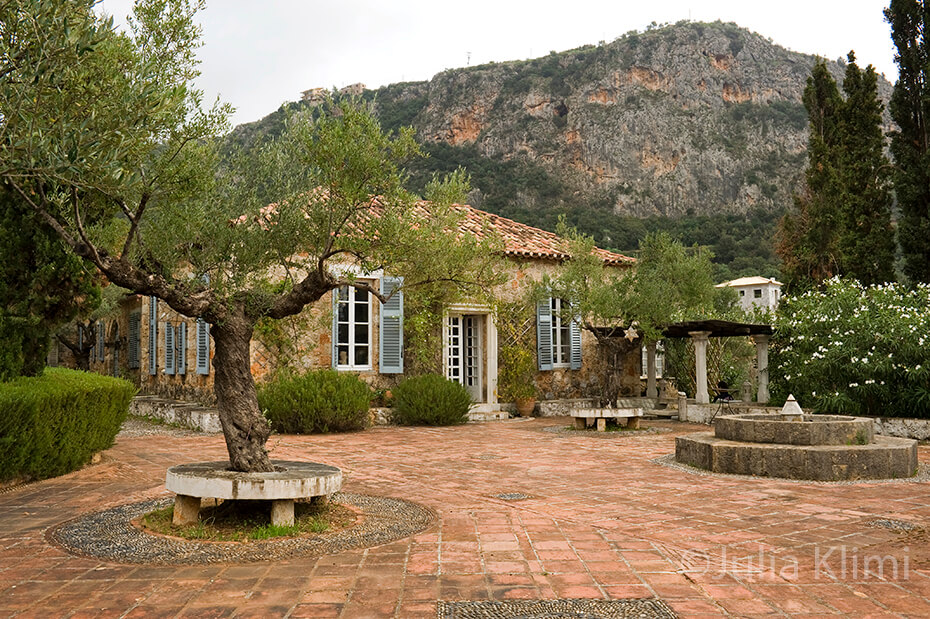
November 8, 2010 Paddy's name day, interior of the house Kardamili

November 8, 2010 Paddy's name day, interior of the house Kardamili, Mani
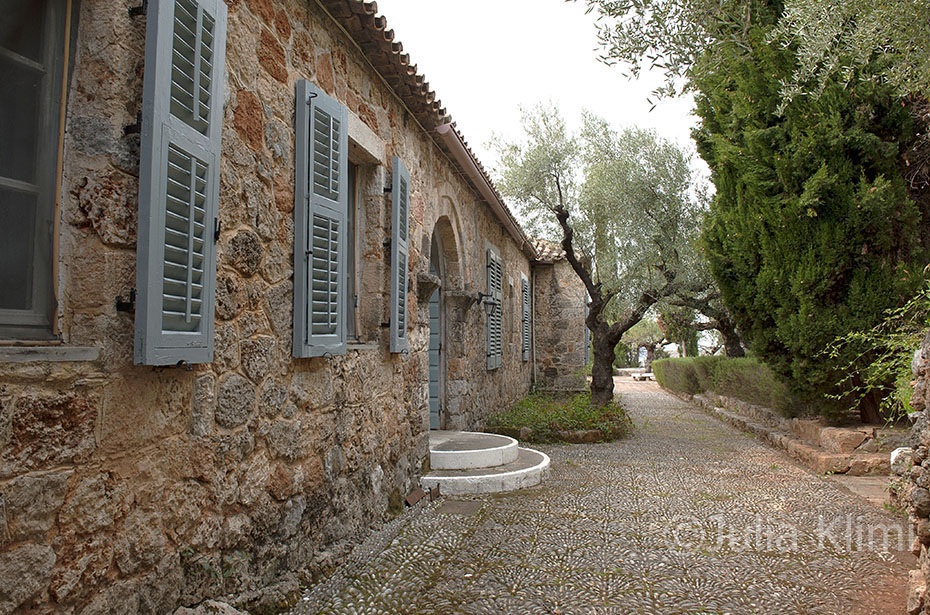
November 8, 2010 Patrick Leigh Fermor house Kardamili, Mani Greece

November 8, 2010 Paddy's name day, interior of the house Kardamili

November 8, 2010 Paddy's name day, interior of the house in Kardamili, Mani Greece
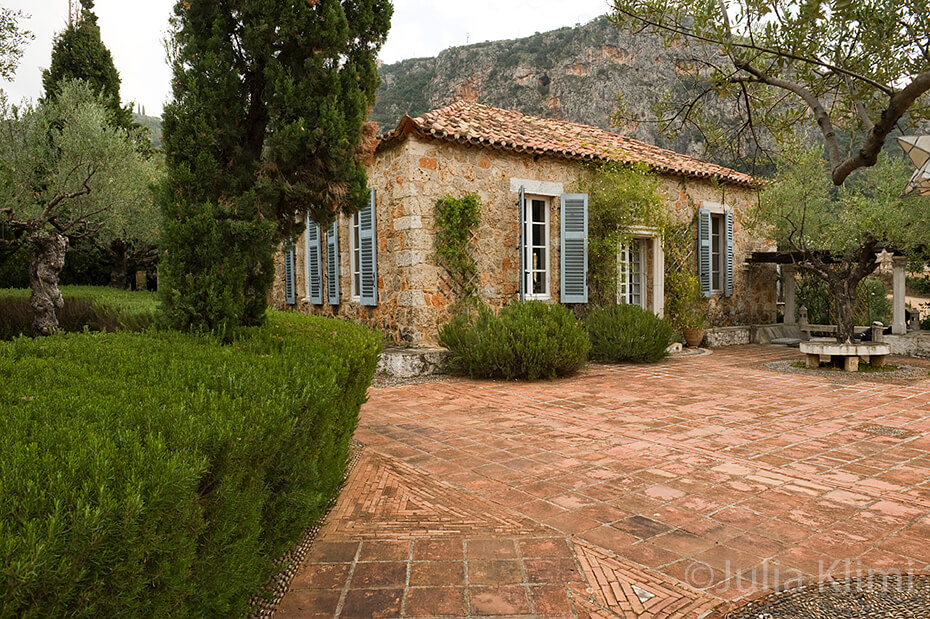
November 8, 2010 Patrick Leigh Fermor house Kardamili, Mani Greece

November 8, 2010 Paddy's name day, interior of the house in Kardamili, Mani Greece
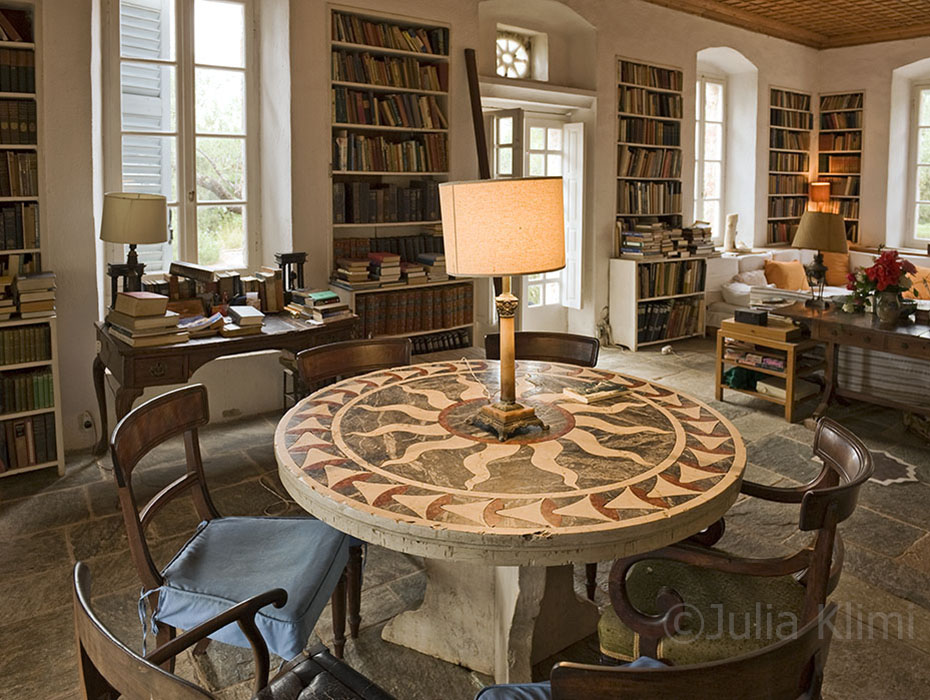
November 8, 2010 Paddy's name day, interior of the house Kardamili
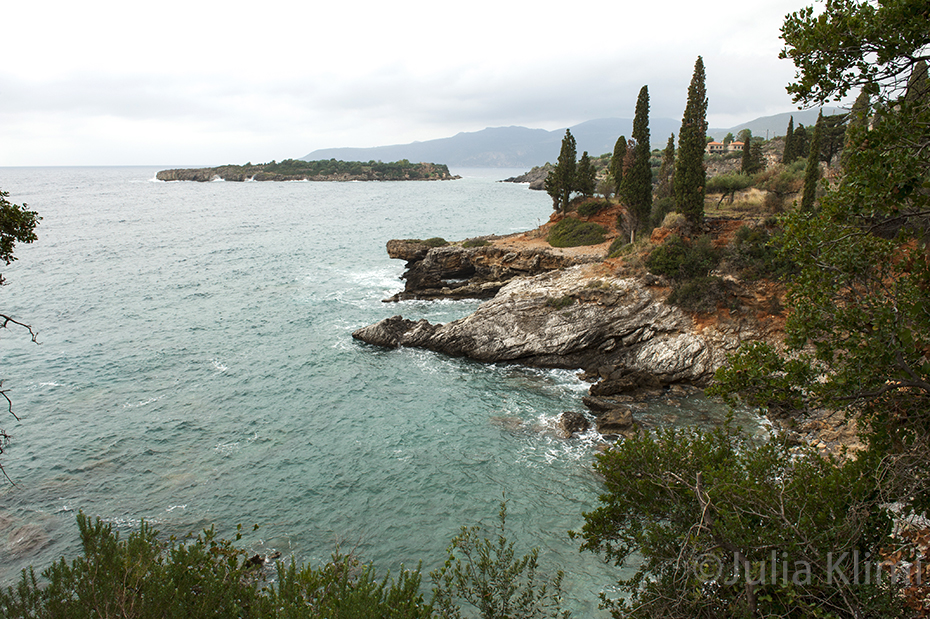
Patrick Leigh Fermor house Kardamili 2010 Mani Greece;
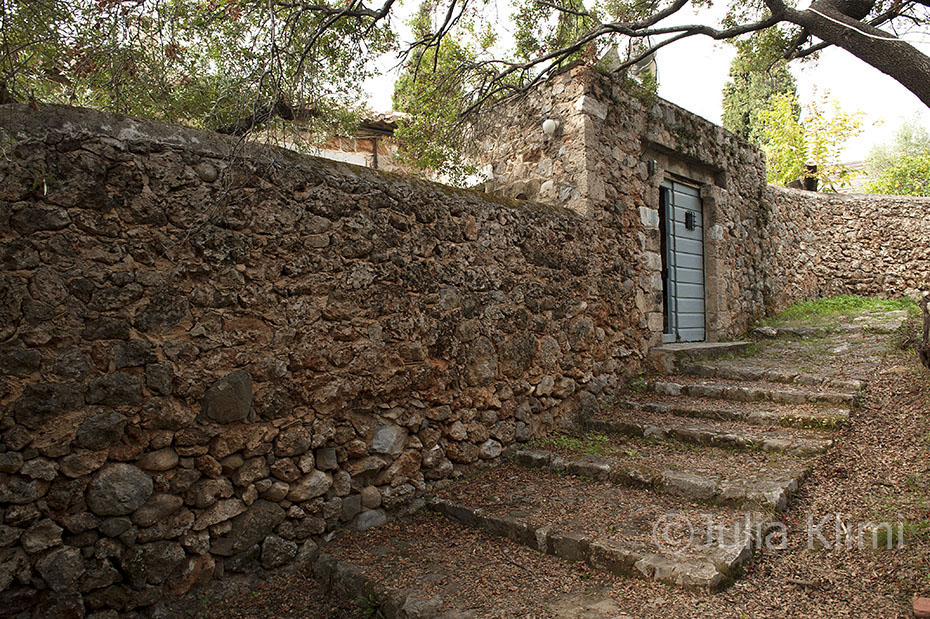
Patrick Leigh Fermor house Kardamili 2010, Mani Greece
Με ρώτησε τι φωτογραφίζω, του μίλησα για το βιβλίου μου At home in Greece (Thames & Hudson 2004) και την ιδέα του βιβλίου, με ρώτησε αν το έχω μαζί μου να το δει, απάντησα αρνητικά «Τι κρίμα» έκανε μια κίνηση με το χέρι του, δυσαρεστήθηκε πραγματικά. Κρίμα γιατί θα χαιρόμουν τόσο πολύ να του το χάριζα. Μάλιστα ένα από τα σπίτια του βιβλίου μου (Ρόδος 17ος αιώνας) αναπαλαιώθηκε από τον εξαιρετικό αρχιτέκτονα/γνώστη της παραδοσιακής αρχιτεκτονικής Νίκο Χατζημιχάλη, τον ίδιο που σχεδίασε τούτο το σπίτι. Του έτεινα τη Μάνη, μου έγραψε αφιέρωση με ένα τελετουργικό τρόπο, ύστερα πήγαμε στην μεγάλη βεράντα που εκείνη την ώρα είχε ένα υπέροχο απογευματινό φως, τον φωτογράφισα φευγαλέα. Ο γιατρός Ορφανίδης, πρότεινε να μας φωτογραφήσει μαζί, αισθανόμουν πάρα πολύ οικεία μαζί του οπότε τον έπιασα αγκαζέ.
Μετά με κάλεσε να με ξεναγήσει στο σπίτι. Μπήκαμε στο καθιστικό “the chief room!!!” αναφώνησε (το κυρίως δωμάτιο), μου έδειξε τις βιβλιοθήκες ολόγυρα, ας έμενα εδώ δυο τρείς μέρες ξεχασμένη σκεφτόμουν. Θαύμασα το ξύλινο ηπειρώτικο ταβάνι, τα έργα τέχνης στους τοίχους (μεταξύ άλλων του φίλου του Νίκου Χατζηκυριάκου Γκίκα) το Οθωμανικού στιλ τζάκι, την πηλιορείτικη πέτρα στο δάπεδο που κάλυπτε όλους τους εσωτερικούς χώρους. Η σέρα με τα τζάμια που βλέπουν στο πράσινο του κήπου ήταν έκπληξη. “Ααα, αυτό είναι ένα αγγλικό conservatory και χαγιάτι ταυτόχρονα! Τι υπέροχη ιδέα! Και τι εκπληκτικό τραπέζι!” του είπα. «Ναι εγώ το ζωγράφισα, είναι ο ήλιος! Ενώ το κάτω μέρος είναι στήριγμα απο παλαίο μπαλκόνι» είπε με ενθουσιασμό Και οι καρέκλες, τόσο κλασικές «Μα εσείς έχετε διαλέξει ότι καλύτερο διαθέτει η Ελλάδα!» Μου απάντησε ότι όλα αυτά τα δημιούργησαν με την σύζυγο του την φωτογράφο Joan Elizabeth Rayner, την κυρία Ιωάννα για τους Μανιάτες κι ότι όλα παρέμεναν στην θέση που τα άφησε εκείνη. Έβγαλα μερικές φωτογραφίες το σπίτι, καθίσαμε λίγο ακόμα στην βεράντα κι ύστερα σηκώθηκα και του έσφιξα το χέρι δυνατά, ευχαριστώντας τον από καρδιάς για τον χρόνο του, διαισθανόμουν ότι ο κόσμος της συγγραφής του ήταν εξαιρετικά πολύτιμος οπότε όσο πιο γρήγορα επέστρεφε τόσο καλύτερα.
Χάζεψα λίγο ακόμα το σπίτι, το κάθε τι φαινόταν μελετημένο μέχρι την τελευταία λεπτομέρεια. Μεγάλο καθιστικό για άνεση με τους φίλους, φυσικά υλικά, ξύλο για το ταβάνι, πέτρα για το δάπεδο, με φόντο τι άλλο; βιβλία. Και πόση προσωπική εργασία και αγάπη για να γίνει ένα με το περιβάλλον και την τοπική βλάστηση. Κοιτάζοντας το από την βορειοδυτική πλευρά η πρώτη εντύπωση είναι ενός τυπικού σπιτιού της Πελοποννήσου μονώροφο, από πέτρα και κεραμοσκεπή. Από την νοτιοανατολική πλευρά όμως οι δύο όροφοι – που δημιουργήθηκαν λόγο της υψομετρικής διαφοράς του εδάφους- κυρίως όμως οι καμάρες της λότζας με την σκάλα ακόμα και τα βοτσαλωτά στα δάπεδα παραπέμπουν σε ένα βυζαντινό σπίτι σαν αυτά της Μονεμβασιάς ή μοναστήρι.
Ακόμα και το εσωτερικό όπου όλοι οι χώροι επικοινωνούν μεταξύ τους μέσω της λότζας θα μπορούσε να πει κανείς ότι σχεδιάστηκε με την λογική των βυζαντινών μοναστηριών που ο Paddy θαύμαζε απεριόριστα.
Όπως είχε συμφωνηθεί το 1996 με τον Sir Patrick και την σύζυγο του, η κατοικία μετά τον θάνατό του το 2011 περιήλθε στην κατοχή του Μουσείου Μπενάκη για να συντηρηθεί και να γίνει κέντρο έρευνας και φιλοξενίας σημαντικών προσωπικοτήτων των γραμμάτων και των τεχνών. Tο Ίδρυμα Σταύρος Νιάρχος έχει αναλάβει την αποκατάσταση και τώρα γίνεται η αναπαλαίωση όλων των κτισμάτων που αποτελούν το σπίτι και το κτήμα των εννέα στρεμμάτων με τον ελαιώνα.
He asked me about my job as a photographer and I told him about my book At Home in Greece (Thames & Hudson, 2004) and the idea behind it. He asked if I had it with me, and when I told him no said, “What a shame,” and made a gesture that expressed his disappointment. I thought how much I would have loved to have given it to him. In fact, one of the homes presented in the book – a 17th century house on Rhodes – was restored by Nikos Hatzimihalis, an excellent architect and expert on traditional architecture, who happened to be the very same architect who had designed this home. I handed him my copy of his book Mani and he signed it for me, adding some words in a very ritualistic manner. We went out to the patio, where I took a few fleeting pictures of him in the beautiful afternoon light. When Dr. Orphanides offered to take a picture of us, I took his arm, feeling quite intimate with him.
Then he offered to show me the house. We entered through the living room – “the chief room” – as he called it, where he showed me the library which lined all of the walls, and I thought to myself that I would love to stay here for two or three days, totally forgotten by the world. I admired the wooden carved ceiling, which was modelled after the ceilings of mansions in Ipiros, the art works on the walls (among them a painting by his friend NikosHadjikyriakos-Ghikas, a leading Greek painter), the Ottoman fireplace and the floor, paved with stones from Pelio.
The sunroom, with its windows overlooking the garden, was a true surprise. “Oh, that’ssimultaneously an English conservatory and a hayati. (A hayati is a covered balcony in Greek folk architecture). What a wonderful idea! And what a wonderful table!” I said.“I painted it myself, he told me enthusiastically. “It depicts a sun. The legs of the table are balcony corbels.”
“And the chairs, so classically Greek! You have chosen the very best of Greece!” I went on in childish excitement. He replied that all these furnishings he had created with his wife, Joan Elizabeth Rayner, (Kyria Ioanna to the locals), and that every piece had remained exactly where she had left it at the time of her death. I took a few pictures of the house. We sat on the patio for awhile, and then I got up, shook his hand vigorously and thanked him for his precious time, because I felt that his writing was extremely important and that the sooner he returned to his work the better.
I browsed around the house a little longer, observing that its every last small detail had been meticulously thought out. A large sitting area for spending time with friends, natural materials–wood for the ceiling, stone for the floor– and in the background …what else? Books. And how much work and love had been involved in integrating the house with the natural environment and the local vegetation. From the northwest, the impression was that of a typical Peloponnesian single-story home with stone walls and tiled roof, though from the southeastern side, it was apparent that the two floors had been made possible by the drop of the slope there. The arches of the loggia, with the stairs and the pebbled floor, matched the Byzantine architecture of Monemvasia, and the Byzantine monastic architecture. All the rooms of the house communicate through the loggia, a feature that reflects the floor plans of the Byzantine monasteries that Paddy admired enormously.
In 1996, Patrick and Joan Leigh Fermor bequeathed their home to the Benaki Museum (which acquired ownership after Patrick’s death in 2011), in order to host important figures of letters and arts who sought a quiet place to work. The Stavros Niarchos Foundation will fully cover the repair works for the restoration of all the buildings located in the olive grove on the 9,000-square-meter estate.
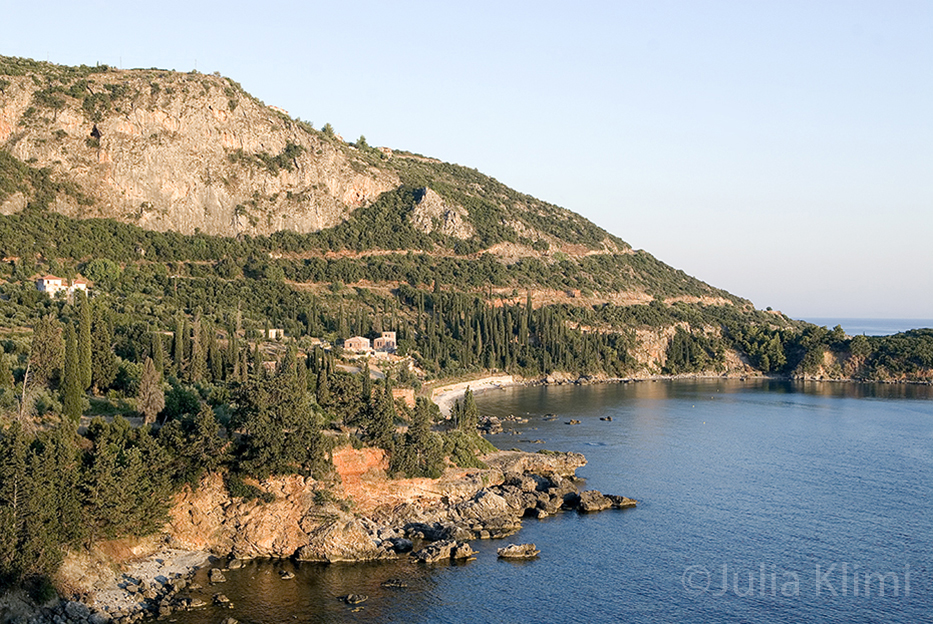
Patrick Leigh Fermor Kardamili 2007 Mani Greece;
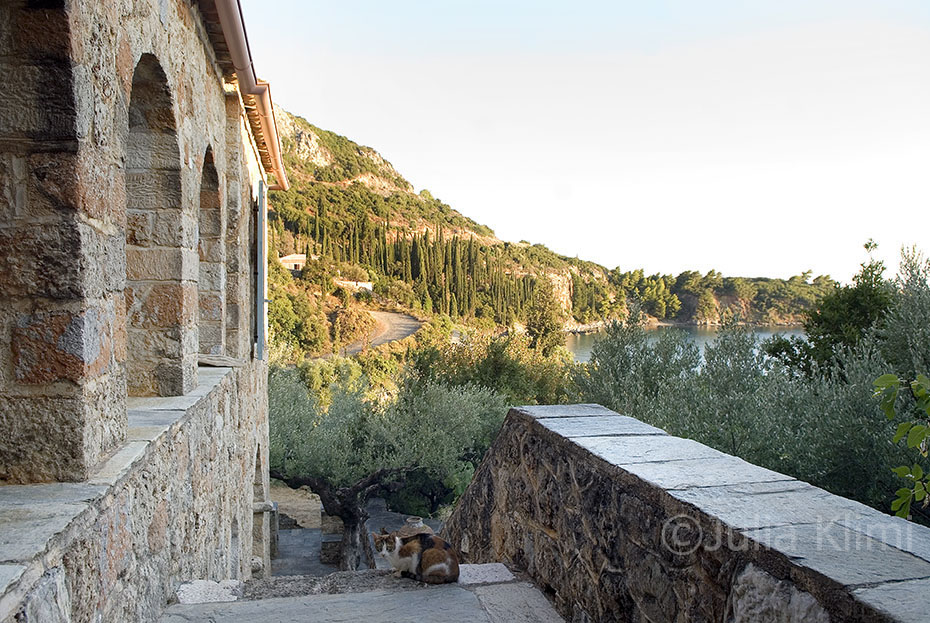
Patrick Leigh Fermor house Kardamili 2007, Mani Greece
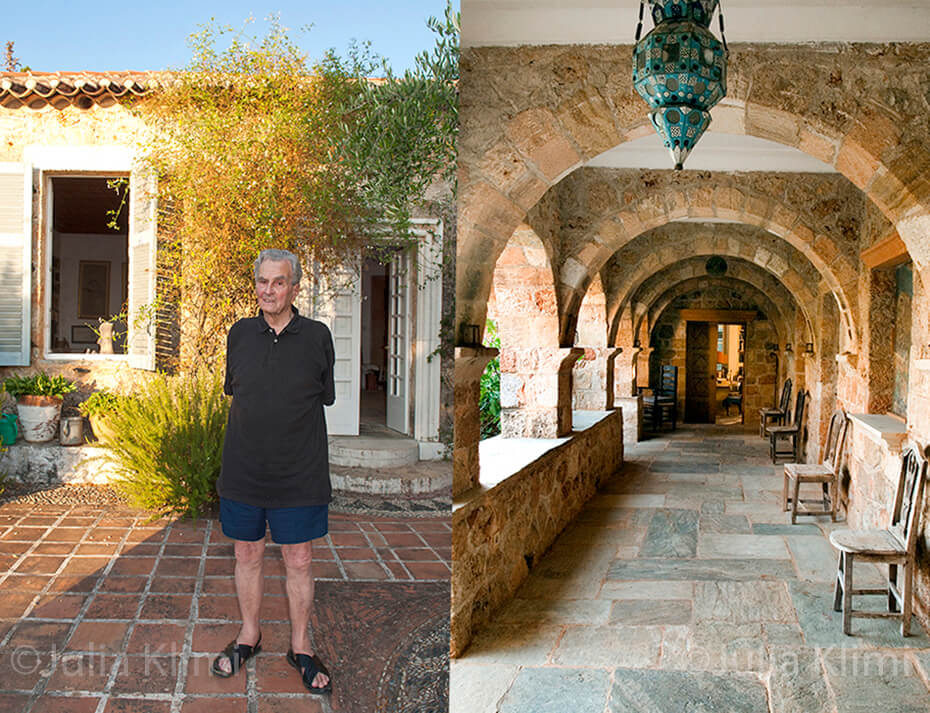
Patrick Leigh Fermor Kardamili 2007
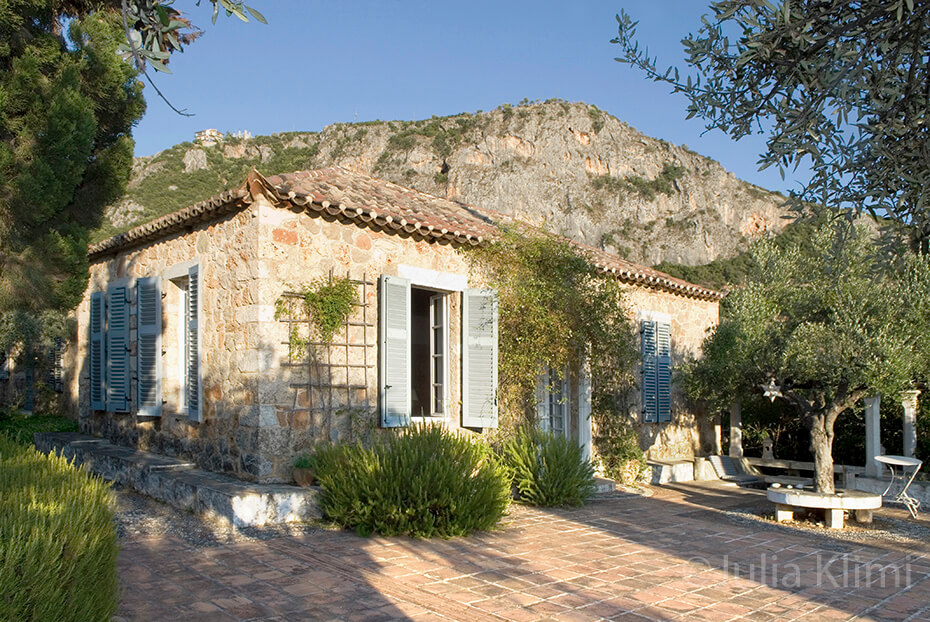
Patrick Leigh Fermor house Kardamili 2007 Mani Greece;

Patrick Leigh Fermor house Kardamili 2007 Mani Greece;
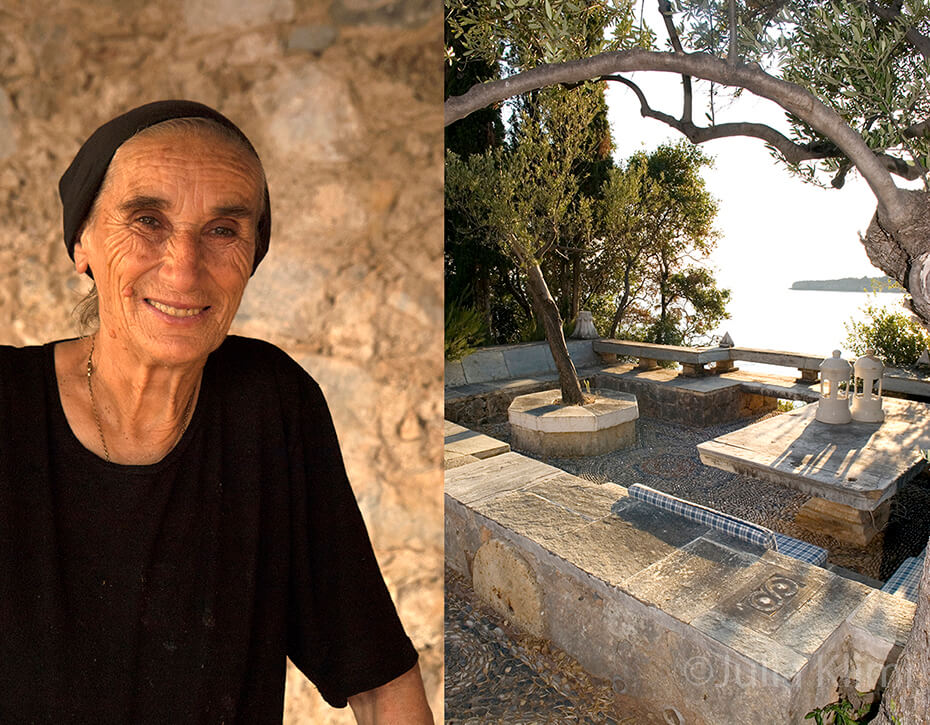
Paddy's friend Lela & Fermor's house Kardamili 2007 Mani Greece;

Patrick Leigh Fermor Kardamili 2007, Mani Greece
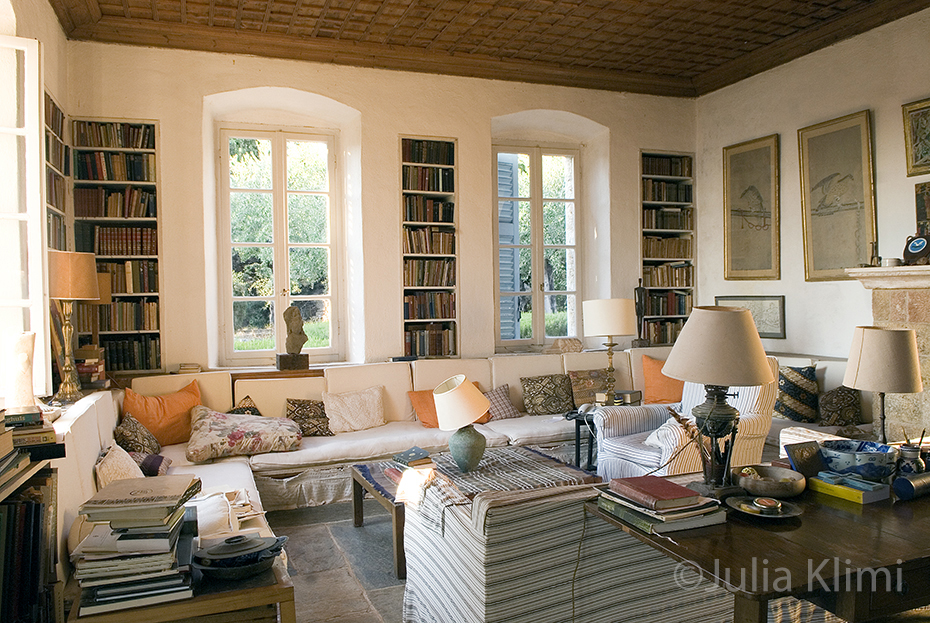
Patrick Leigh Fermor house Kardamili 2007, Mani Greece
Οι βασκανίες και γιατί θέλησα να τον συναντήσω
Όταν στα μέσα της δεκαετίας του ‘90 άρχισα να γράφω ταξιδιωτικά ρεπορτάζ θέλησα να διαβάσω κάτι παραπάνω από τον Καζαντζάκη. Ανάμεσα στα άλλα ξεχώρισα το Σελίδες για την Ελλάδα του Michel Deon, τον Κολοσσό του Μαρουσίου του Χένρυ Μίλερ, την Ρούμελη και την Μάνη του Patrick Leigh Fermor. Τα δυο τελευταία, και κυρίως η Μάνη, ήταν μια αληθινή αποκάλυψη για μένα. Αναπάντεχα μου φανερώθηκε η αληθινή Ελλάδα (του 1950/60) που δεν διέφερε πολύ από την Όλυμπο της Καρπάθου που φωτογράφιζα/μελετούσα εκείνη την εποχή.
Στις σελίδες των βιβλίων του Sir Patrick ανακάλυψα πως μέσα από τις καθημερινές συνήθειες των ανθρώπων – τις σημαντικές λεπτομέρειες – αποκαλύπτεται ο χαρακτήρας ενός τόπου, η κοσμοθεωρία του Έλληνα, όπως διαμορφώθηκε μέσα από την ιστορία, τις παραδόσεις και τις προλήψεις που κατά τον Fermor “Σε τίποτα δεν φαίνεται πιο καθαρά η συνέχεια της Αρχαίας Ελλάδας όσο στις προλήψεις και τις παγανιστικές και θρησκευτικές συνήθειες που ακόμα επικρατούν στα βουνά και τα νησιά.” Πόσο δίκιο είχε.
Τα έθιμα του Πάσχα και συγκεκριμένα της Λαμπρής Τρίτης στην Όλυμπο της Καρπάθου το Πάσχα 1993, ήταν για μένα η αφορμή ενός μεγάλου “ταξιδιού” καταγραφής και φωτογράφησης ολόκληρης της ζωής του χωριού τα επόμενα χρόνια. Εκείνο το Πάσχα η λιτάνευση των εικόνων από τις κοιλάδες και τους γύρω λόφους μέχρι το νεκροταφείο για την «αναγγελία της Ανάστασης των νεκρών” με τους συγγενείς των νεκρών να μοιράζουν προσφορές στους παρευρισκόμενους, με ξάφνιασαν οικεία. Η βρώση των εδεσμάτων πάνω στους τάφους και η ευλογία της γης, να είναι καρπερή κτλ με πήγαν κατευθείαν στην Διονυσιακή λαϊκή λατρεία και τα έθιμα που κατέγραφε ο πατέρας μου Οδυσσέας Κάρολος Κλήμης στα λαογραφικά βιβλία του. H «ευρωπαϊκή» Κέρκυρα της πόλεως και πατρίδα μου με τις μελωδίες της κλασσικής μουσικής μπορεί να μην έχει τίποτα κοινό με την Όλυμπο, η κερκυραική ύπαιθρος όμως με τα αρχαιοελληνικά έθιμα του Πάσχα κι εκείνα της Αποκριάς, τον “γέρο” και την “γριά”, τον καρνάβαλο που καίγεται, ταυτίζονται απόλυτα. Σε ολόκληρη την Ελλάδα τα έθιμα αποκριάτικα, πασχαλινά, οι βασκανίες όπως το μάτιασμα κ.α. έχουν αρχαιοελληνικές/παγανιστικές ρίζες κι ο Fermor λέει ότι αυτό ουσιαστικά είναι που ενώνει ολόκληρη την Ελλάδα – ακόμα και την Κέρκυρα με την Κάρπαθο θα έλεγα – κι έχει απόλυτα δίκιο, το βροντοφωνάζει και θυμώνει με τους “καινούργιους και ημιμαθείς αστούς…” “…που αρνούνται την ύπαρξη τους (των εθίμων), κατηγορώντας τα για “οπισθοδρομικά, πρωτόγονα” και πάνω από όλα “μη Ευρωπαϊκά” (Μάνη, σελ 232-233).
Ξαναπήγα στο σπίτι του Sir Patrick τον Νοέμβρη του 2010, αυτή τη φορά τυχαία – με φίλους που μένουν στον Αγιο Νικόλα- κατά σύμπτωση ήταν η μέρα της γιορτής του (Μιχάλης), αλλά τότε δεν το ήξερα. Με θυμήθηκε η οικονόμος, η οποία μου είπε ότι ο κυρ Μιχάλης δεν μπορούσε να μιλήσει, ήταν κλινήρης, λυπήθηκα πολύ, μείναμε για λίγο, έβγαλα μερικές φωτογραφίες. Τον επόμενο Ιούνιο στα 96 του πέρασε στην αθανασία.
Τα βιβλία, το σπίτι, το κτήμα, οι σχέσεις με τους ντόπιους, αποκαλύπτουν την αφοσίωση του στην Ελλάδα. Κι όπως και του ήρωα του, του Λόρδου Βύρωνα ήταν μια αγάπη βιωματική που γεννήθηκε από την γνωριμία των ανθρώπων κάθε κοινωνικής τάξης αλλά και την βαθιά του γνώση σε κάθε τι Ελληνικό. Είναι γνωστό ότι όσο πιο πολύ γνωρίζεις ένα τόπο τόσο πιο πολύ τον αγαπάς. Τον εκτίμησα για την βαθιά του γνώση στο τι εστί Ελλάδα/’Ελληνες αλλά και γιατί μπορούσα να νιώσω πραγματικά, από που τροφοδοτείται αυτός ο μεγάλος έρωτας για την Ελλάδα.
Ο Sir Patrick είναι ο δικός μου ήρωας.
Τζούλια Κλήμη
*Τελικά το The Broken Road (2013) όπως είναι ο τίτλος του τρίτου τόμου της τριλογίας του μεγάλου ταξιδιού που χρειάστηκε μια ζωή για να γραφτεί, παρέμεινε ημιτελές, η τελική επεξεργασία έγινε μετά το θάνατο του από τον διάσημο ταξιδιωτικό συγγραφέα Colin Thubron και την βιογράφο και φίλη του Άρτεμις Κούπερ – το βιβλίο ολοκληρώθηκε με το πολύ ενδιαφέρων ταξίδι του Fermor στο Άγιο Όρος. Στα ελληνικά κυκλοφορεί η συγκεντρωτική έκδοση Η πορεία προς την Κωνσταντινούπολη η οποία περιλαμβάνει τα δύο πρώτα βιβλία της τριλογίας, Η εποχή της δωρεάς (το ταξίδι από την Ολλανδία μέχρι την ουγγρική μεθόριο) και Ανάμεσα στα δάση και τα νερά (το ταξίδι από τη Βουδαπέστη ως τις Σιδηρές Πύλες του Δούναβη). Εκδόσεις Μεταίχμιο 2013
www.patrickleighfermorsociety.org.
The evil eye and the reason why I wanted to meet him
When, in the mid-1990s I started my career as a photographer and travel writer, I wanted to delve into travel literature. Besides the classic books of Kazantzakis, my attention was drawn by Michel Déon’s Page Grecques, Henri Miller’s The Colossus of Maroussi, and Patrick Leigh Fermor’s Roumeli and Mani. Of the latter two, Mani was a true revelation, revealing to me quite unexpectedly, the ‘authentic’ Greece of the 1950-60s, which I was seeing at the time in Olymbos, a village on the island of Karpathos which I was photographing that period.
Within the pages of Fermor’s books I discovered that it is the details of everyday life that reveal the character of a place, the world view of the Greeks as shaped by history, tradition, and superstition. Fermor believed that nothing indicated the continuity of ancient Greece in a more straightforward fashion than the preconceptions and habits, pagan and religious, that still prevailed in the remote mountains and islands. He was so right about this.
It was during the Easter of 1993 that the customs of the village of Olymbos, and in particular, those of Good Tuesday, launched me on a long “journey” of recording and photographing the life of the village during the following years. The litany of the icons in the valleys and the surrounding hills that we passed through, culminating in the cemetery for the “announcement of the resurrection of the dead,” and the offerings that the relatives handed out to the bystanders, surprised me. The ritual of eating food on the tombs and blessing the earth for its productivity reminded me of the Dionysian folk cults, along with the customs that my father, Odysseus-Karolos Klimis, documented in his laographic books.
Corfu, my hometown with its European influences -litanies, symphonic music- has nothing in common with the Karpathian village of Olymbos, but in the countryside of Corfu island the Easter and Carnival customs have roots in the ancient Greek traditions, and the customs involving figures such as the “old man and the old woman”, as well as the “burning of the ‘carnavalos’ (a human effigy)” they are totally identical to those of Karpathos, which as one would expect, have roots in ancient Greece.
Throughout Greece, the customs, whether those of Easter or of Carnival, have deep pagan root from ancient Greece, and Fermor suggests in his books that this is what unifies Greece (from Corfu to Karpathos, I might add). Actually Fermor was known to thunder angrily at the nouveaux sophomoric bourgeoisie who denied, or merely ignored the existence of those customs and scorned them as backward, “primitive” (and above all) “non-European.”
I returned to the house of Sir Patrick on November, 2010, this time by chance, with friends who live in Aghios Nicholas, a neighboring village. By coincidence, it happened to be the day of the celebration of his Greek name-day, Mihalis (back then I didn’t know that). The housekeeper remembered me. He told me that Paddy was bedridden and couldn’t talk, which made me very sad. We stayed for a little while and I took some photos. The following year, in June, at the age of 96, Sir Patrick passed away and attained immortality.
Fermor’s books, house, estate, relations with the locals, all reveal his love and dedication to Greece. And like his hero, Lord Byron, it was an experiential love that was born out of his acquaintance with Greeks on all social levels, and his deep knowledge of everything Greek. It is well known that the more you get to know a place the more you love it. I deeply appreciated him for his cultivation, and because I could actually empathize with his great love for Greece and understand how it was fed.
Sir Patrick is my hero.
* The last book of the trilogy The Broken Road: From the Iron Gates to Mount Athos (2014) remained incomplete. The final editing was done by the famous travel writer, Colin Thubron, and Fermor’s biographer, Artemis Cooper. The book describes that last part of his great walk from the Iron Gates of the Danube to Constantinople, and ends with a most interesting visit of the writer to Mount Athos.
www.patrickleighfermorsociety.org.
Όλες οι φωτογραφίες και τα κείμενα του δικτυακού τόπου καλύπτονται από τον Νόμο 2121 / 1993 και τους κανόνες Διεθνούς Δικαίου. Επίσης έχουν copyright. Αν θέλετε να χρησιμοποιήσετε κάτι μην διστάσετε να απευθυνθείτε στην δημιουργό.
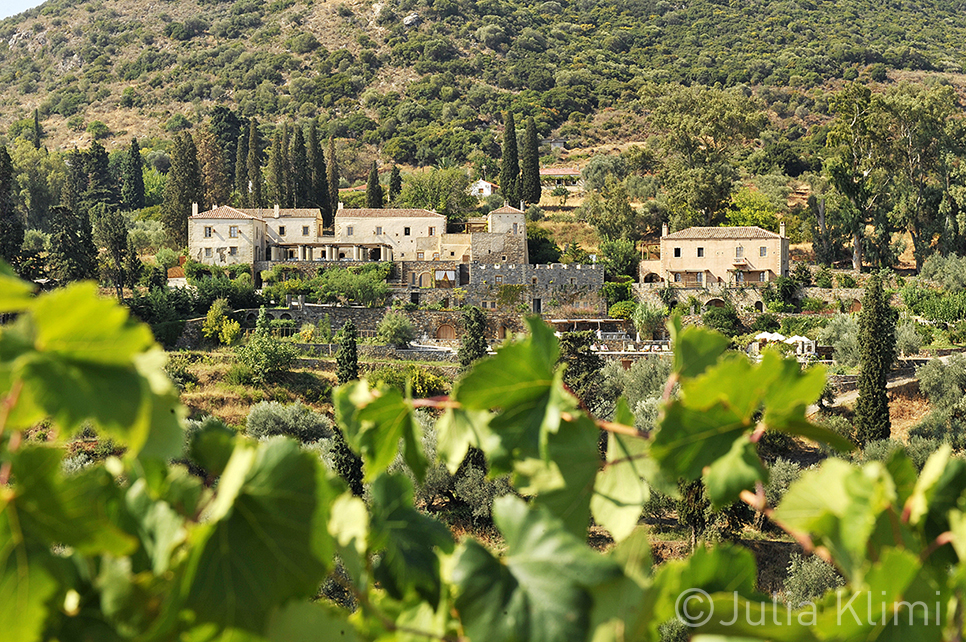


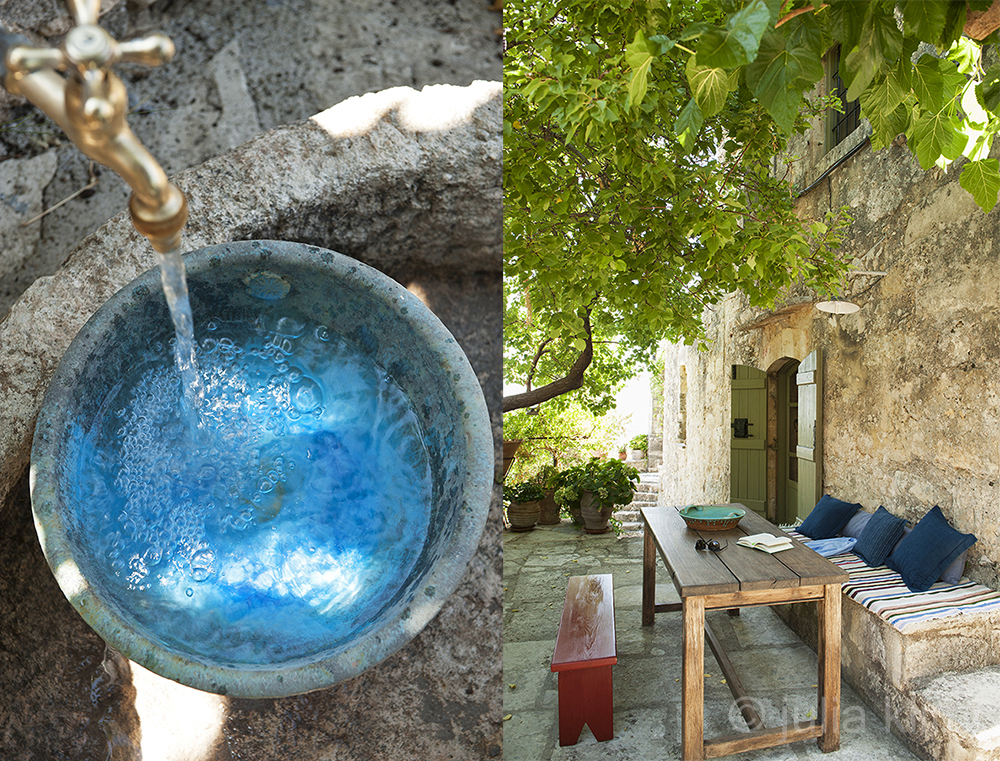
2 Comments